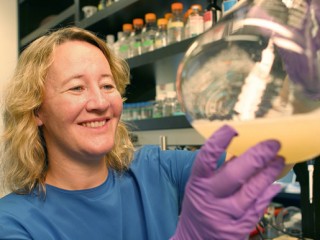
Carol W. Greider biography
Date of birth : 1961-04-15
Date of death : -
Birthplace : San Diego, California, U.S.
Nationality : American
Category : Science and Technology
Last modified : 2011-09-20
Credited as : molecular biologist, DNA damage, Nobel Prize in Physiology or Medicine
0 votes so far
For their work with telomerase, Greider and Blackburn were awarded the Nobel Prize in Medicine in 2009, sharing the honor with Jack W. Szostak. Greider currently works at Johns Hopkins University, where her laboratory studies the effect of telomeres on cell death, DNA stability, regenerative disease, and the potential relationship between stem cells and telomerase. As a child she suffered from dyslexia, and as a young woman she competed as a triathlete (swimming, cycling, and running). Her father, Kenneth Greider, was a long-time quantum physicist at UC Davis, and her husband, Nathaniel Comfort, is a well-known author and science historian.
Today, so many papers are published with the keyword "telomerase" in the titleabout 1,000 each year, at last countthat Greider cannot keep up with them all. Still, she delights in how the field's research questions multiply and expand with each new finding. "I see telomeres as having taken me for a ride," says Greider, who was elected to the National Academy of Sciences in 2003. Her work began in biochemistry but has changed over the years to intersect with the fields of cellular senescence, cancer, DNA recombination, and stem cell failure. In her Inaugural Article (1), published in this issue of PNAS, Greider explores the structure of the RNA subunit of telomerase. "It's fun, because I picked one topic, but the fields keep changing, so I have to keep learning along the way," she says.
Awards and honors:
American Academy of Microbiology
American Academy of Arts and Sciences
American Association for the Advancement of Science
American Society for Cell Biology
Geron Corporation Scientific Advisory Board Member (1992-96)
National Academy of Sciences 2003
National Institutes of Health
Dickson Prize 2006
Paul Ehrlich and Ludwig Darmstaedter Prize 2009 (with Elizabeth H. Blackburn)
Horwitz Prize 2007 (with Elizabeth H. Blackburn and Joseph Gall)
Lounsbery Award 2003
Gairdner Foundation International Award 1998 (with Elizabeth H. Blackburn)
Lasker Award 2006 (with Elizabeth H. Blackburn and Jack W. Szostak)
Nobel Prize for Medicine 2009 (with Elizabeth H. Blackburn and Jack W. Szostak)
Pew Scholar 1990
Wiley Prize in Biomedical Sciences 2006 (with Elizabeth H. Blackburn)
Risk Factors: Dyslexia
















